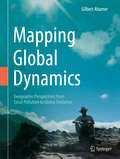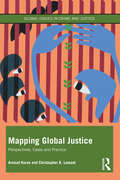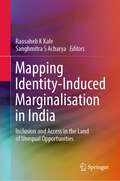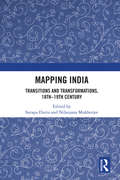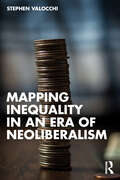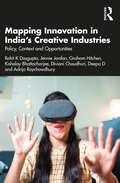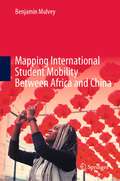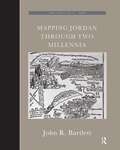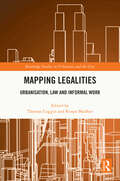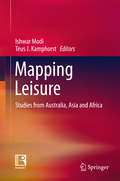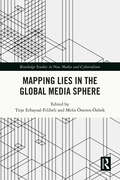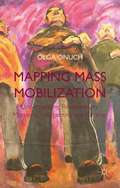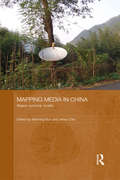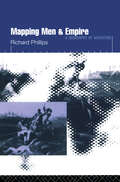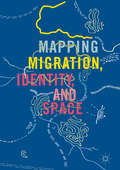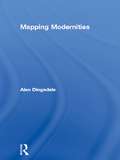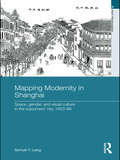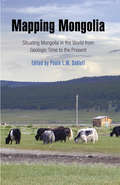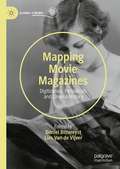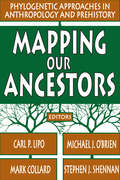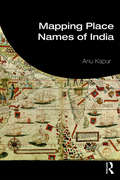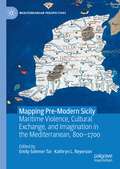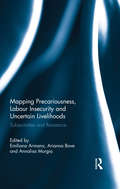- Table View
- List View
Mapping Global Dynamics: Geographic Perspectives from Local Pollution to Global Evolution
by Gilbert AhamerThis book asks: What are the most suitable “mapping strategies” for detecting patterns of global dynamics?It adopts a spatial perspective when trying to understand “Global Dynamics” – and sets out to revolutionise the concept of space as such. Spatial views – on levels of increasing abstraction, reflection and self-organisation – are developed along eight case studies including air emissions, environmental radioactivity, deforestation, energy from biomass, land use change, food supply, water quality and cooperative interdisciplinary learning for global change.This book’s conceptual innovation consists in performing a transformation from “space & time” into “functional state space & evolutionary time” in order to better recognise the structural patterns of long-term global dynamics. A transdisciplinary readership in academia – including geography, philosophy, economics, global change and future research – that is interested in enlarging scientific concepts beyond classical borders – would be most welcome!
Mapping Global Justice: Perspectives, Cases and Practice (Global Issues in Crime and Justice)
by Christopher K. Lamont Arnaud KurzePersistent international conflicts, increasing inequality in many regions or the world, and acute environmental and climate-related threats to humanity call for a better understanding of the processes, actors and tools available to face the challenges of achieving global justice. This book offers a broad and multidisciplinary survey of global justice, bridging the gap between theory and practice by connecting conceptual frameworks with a panoply of case studies and an in-depth discussion of practical challenges. Connecting these critical aspects to larger moral and ethical debates is essential for thinking about large, abstract ideas and applying them directly to specific contexts. Core content includes: Key debates in global justice from across philosophy, postcolonial studies, political science, sociology and criminology The origins of global justice and the development of the human rights agenda; peacekeeping and post-conflict studies Global poverty and sustainable development Global security and transnational crime Environmental justice, public health and well-being Rather than providing a blueprint for the practice of global justice, this text problematizes efforts to cope with many justice related issues. The pedagogical approach is designed to map the difficulties that exist between theory and praxis, encourage critical thinking and fuel debates to help seek alternative solutions. Bringing together perspectives from a wealth of disciplines, this book is essential reading for courses on global justice across criminology, sociology, political science, anthropology, philosophy and law.
Mapping Identity-Induced Marginalisation in India: Inclusion and Access in the Land of Unequal Opportunities
by Raosaheb K Kale Sanghmitra S AcharyaThis book discusses the issues of inequality and marginalization in India. The first section of the book contextualizes sociological traditions for the scrutiny of subaltern discourse on discrimination. The chapters in the section explore self-identity, ‘margins’ in sociological traditions, subalternity and exclusion, citizenship issues of de-notified tribes, the role of religion for scheduled tribe Dalits and Ambedkar’s ideas on tribes. The second section deals with the political economy of higher education, health and employment. The efforts of BR Ambedkar and the consequences of those efforts, his critique of education policies during British time and its alteration for independent India have been meticulously dealt with. The third section illustrates an application of theoretical understanding through narratives of labour bondage in Varanasi, sanitation workers in Mumbai and rickshaw pullers in Delhi. The last section establishes that unequal access to resources is a consequence of discrimination and marginalization induced by social identities. The book argues for equitable access to resources and opportunities to ensure health equity. The audience for this publication includes academics, researchers, health professionals, policymakers engaged with discrimination, exclusion, marginalization and inequity in health.
Mapping India: Transitions and Transformations, 18th–19th Century
This book presents an alternate history of colonial India in the 18th and the 19th centuries. It traces the transitions and transformations during this period through art, literature, music, theatre, satire, textiles, regime changes, personal histories and migration. The essays in the volume examine historical events and movements which questioned the traditional parameters of identity and forged a new direction for the people and the nation. Viewing the age through diverse disciplinary angles, the book also reflects on the various reimaginings of India at the time. This volume will be of interest to academics and researchers of modern Indian history, cultural studies and literature. It will also appeal to scholars interested in the anthropological, sociological and psychological contexts of imperialism.
Mapping Inequality in an Era of Neoliberalism
by Stephen ValocchiOffering a unique, comprehensive, and critical introduction to increasingly visible social inequalities, this textbook examines the political and economic causes and cultural consequences of a stratifying system that allocates material resources and human dignity on the basis of private profit and labor exploitation.Mapping Inequality in an Era of Neoliberalism foregrounds capitalism as the major source of the power relations in the United States, as a class system that serves the dominant vector of inequality and sets the parameters of social mobility. The book starts with racialized capitalist power and shows how this power is constituted in structures of opportunity and constraint. It also uses ethnographic accounts to “flip the script” to show how individuals in the class structure construct identities.Providing students with tools for understanding, Valocchi engagingly introduces many of the crucial concepts in this area of sociology – power, opportunity structures, ideology, social and cultural capitals, and intersectional class identities – connecting them as part of a uniquely critical approach.
Mapping Innovation in India’s Creative Industries: Policy, Context and Opportunities
by Kishalay Bhattacharjee Jennie Jordan Rohit K Dasgupta Graham Hitchen Diviani Chaudhuri Deepa D Adrija RoychowdhuryThe first in-depth study of the Indian creative industries, this book provides a comprehensive mapping of the Indian creative industries and its policy landscape, developing and defining key concepts and terms and offering detailed case studies of specific sectors, geographic regions and governance structures. Using an ecosystem framework, this book focuses on strategy/policy; tangible and intangible infrastructure; and funding and investment to understand the main drivers and barriers across nine sub-sector value chains. With investment from global brands into many sectors, it tracks how Indian creative industries are fostering innovation and design for social and ecological sustainability. It also delves into India’s informal economy to share key policy insights. The volume will be of great interest to scholars and researchers of public policy, business studies and South Asian studies. It will also be a key document for foreign investors willing to invest in one of the fastest-growing and stable economies in the world.
Mapping International Student Mobility Between Africa and China
by Benjamin MulveyThis book examines an emergent pattern of international student mobility: that of international students from across the African continent who are enrolled on degree programmes at Chinese universities. China is among the most popular destination countries for African students, yet there has been little research to-date into this emergent mobility pattern. Drawing on data from a series of interviews, the book focuses on the specific modalities of integration into the global economy of both the sending region and the host country, and examines how these shape the decision-making, experiences, and future aspirations of mobile students. It also highlights how incipient flows of international student migrants, such as those between various African countries and China, are calling into question a number of the axioms around the study of international study mobility that were developed with reference to more established migration patterns, which tend to flow from other regions to the West. These include, for example, the idea that international students are generally privileged members of the global middle class who seek an education abroad as part of a strategy to accumulate cultural capital and reproduce social privilege. This novel work is of interest to researchers in human geography, sociology, development studies, migration studies, and particularly those studying China-Africa relations.
Mapping Jordan Through Two Millennia (The Palestine Exploration Fund Annual)
by JohnR. BartlettThis book shows how travellers and scholars since Roman times have put together their maps of the land east of the River Jordan. It traces the contribution of Roman armies and early Christian pilgrims and medieval European travellers, Crusading armies, learned scholars like Jacob Ziegler, sixteenth-century mapmakers like Mercator and Ortelius, eighteenth-century travellers and savants, and nineteenth-century biblical scholars and explorers like Robinson and Smith, culminating in the late-nineteenth century surveyors working for the Palestine Exploration Fund. This original and valuable book shows, with full illustrations, how maps of the Transjordan region developed through the centuries, and with its detailed tables and bibliography will aid future scholars in further research.The author took part in archaeological excavations and surveys in Jordan, was Associate Professor of Biblical Studies and Fellow at Trinity College Dublin, has published research papers and books on ancient Jordan. John Bartlett was the editor of the Palestine Exploration Quarterly, and until recently was the Chairman of the Palestine Exploration Fund.
Mapping LGBTQ Spaces and Places: A Changing World
by Donna Gilbreath Maria Rodó-Zárate Michal PitoňákThis book addresses LGBTQ issues in relation to among others law and policy, mobility and migration, children and family, social well-being and identity, visible and invisible landscapes, teaching and instruction, parades, arts and cartography and mapping. A variety of research methods are used to explore identities, communities, networks and landscapes, all which can be used in subsequent research and classroom instruction and disciplinary and interdisciplinary levels. This extensive book stimulates future pioneering research ventures in rural and urban settings about existing and proposed LGBTQ policies, individual and group mapping, visible and invisible spaces, and the construction of public and private spaces. Through the methodologies and rich bibliographies, this book provides a rich source for future comparative research of scholars working in social work, NGOs and public policy, and community networking and development.
Mapping Legalities: Urbanisation, Law and Informal Work (Routledge Studies in Urbanism and the City)
by Roopa Madhav Thomas CogginThis book maps the interactions between informal workers and the law within the urban and spatial environment. It focuses on access to physical space, revealing the punitive ways in which globally law regulates space and informal work which relies on space.Across various cities worldwide, the chapters in this book uncover how informal workers remain at the policy and legal margins of urban society and reveal their ongoing endeavour for social and legal protection within local jurisdictional contexts. It spans multiple themes, ranging from street vending to informal work in the gig economy. They shed light on the collective influence of the law and the pursuit of a modern city in contributing to the marginalisation of informal workers. Despite this, the chapters illuminate the strategies employed by informal workers to leverage the law in acknowledging their contributions and asserting their presence in the city.The book is targeted towards an academic audience and practitioners specialising in law, urban studies, and the informal economy. The reader will gain an in-depth and cross-jurisdictional understanding of the indispensable role played by informal workers in providing services to a broader urban population, ranging from street vendors to sanitation workers and sex workers.
Mapping Leisure: Studies from Australia, Asia and Africa
by Ishwar Modi Teus J. KamphorstThis volume addresses the rich and varied thoughts, concepts, approaches and leisure practices in sixteen countries of three continents---Australia, Asia and Africa. The chapters showcase the diversity in the forms and ways in which the idea and practice of leisure have developed across space and time. However, the common thread through the chapters is that concepts and practices of leisure are found all over the world, from pre-historic settlements to the present-day consumer societies. Seemingly, being at leisure is a capacity of the human species present at birth and which develops in a variety of individual and societal contexts. Even in situations where leisure gets little official recognition as being an aspect of life---such as under colonial rule or in extremely work-centric societies---it needs to be contextually understood. This is a welcome addition to the literature on leisure studies from a global and comparative perspective.
Mapping Lies in the Global Media Sphere (Routledge Studies in New Media and Cyberculture)
by Tirşe Erbaysal-Filibeli Melis Öneren-ÖzbekThis volume addresses the concept of “(in)nocent lies” in the media – beyond the concept of misleading information online, this extends to a deliberate effort to spread misinformation, disinformation and conspiracy theories – and proposes a critical approach to tackle the issue in related interdisciplinary fields. The book takes a multidisciplinary and international approach, addressing the digital divide and global inequality, as well as algorithmic bias, how misinformation harms vulnerable groups, social lynching and the effect of misinformation on certain social, political and cultural agendas, among other topics. Arranged thematically, the chapters paint a nuanced and original picture of this issue. This book will be of interest to students and academics in the areas of digital media, media and politics, journalism, development studies, gender and race.
Mapping Mass Mobilization
by Olga OnuchThrough a paired comparison of two moments of mass mobilization, in Ukraine and Argentina, focusing on the role of different actors involved, this text maps out a multi'layered sequence of events leading up to mass mobilization.
Mapping Media in China: Region, Province, Locality (Routledge Contemporary China Series)
by Wanning Sun Jenny ChioMapping Media in China is the first book-length study that goes below the ‘national’ scale to focus on the rich diversity of media in China from local, provincial and regional angles. China’s media has played a crucial role in shaping and directing the country’s social and cultural changes, and whilst these shifts have often been discussed as a single and coherent phenomenon, this ignores the vast array of local and regional variations within the country’s borders. This book explores media as both a reflection of the diversity within China and as an active agent behind these growing differences. It examines the role of media in shaping regional, provincial and local identities through the prism of media economics and technology, media practices, audiences, as well as media discourses. The book covers a wide range of themes, including civil society, political resistance, state power and the production and consumption of place-specific memory and imagination. With contributions from around the world, including original ethnographic material from scholars based in China, Mapping Media in China is an original book which spans a broad range of disciplines. It will be invaluable to both students and scholars of Chinese and Asian studies, media and communication studies, geography, anthropology and cultural studies.
Mapping Men and Empire: Geographies of Adventure
by Richard PhillipsFirst published in 1996. Routledge is an imprint of Taylor & Francis, an informa company.
Mapping Migration, Identity, and Space
by Timothy H. Parsons Tabea LinhardThis interdisciplinary collection of essays focuses on the ways in which movements of people across natural, political, and cultural boundaries shape identities that are inexorably linked to the geographical space that individuals on the move cross, inhabit, and leave behind. As conflicts over identities and space continue to erupt on a regular basis, this book reads the relationship between migration, identity, and space from a fresh and innovative perspective.
Mapping Modernities: Geographies Of Central And Eastern Europe
by Alan DingsdaleThis text draws on research carried out since 1989/1991 to describe, interpret and explain the place and spatial order of modernities in Central and Eastern Europe since 1920, to give a theoretically underpinned, regional geography of the area
Mapping Modernity in Shanghai: Space, Gender, and Visual Culture in the Sojourners' City, 1853-98 (Asia's Transformations)
by Samuel Y. LiangThis book argues that modernity first arrived in late nineteenth-century Shanghai via a new spatial configuration. This city’s colonial capitalist development ruptured the traditional configuration of self-contained households, towns, and natural landscapes in a continuous spread, producing a new set of fragmented as well as fluid spaces. In this process, Chinese sojourners actively appropriated new concepts and technology rather than passively responding to Western influences. Liang maps the spatial and material existence of these transient people and reconstructs a cultural geography that spreads from the interior to the neighbourhood and public spaces. In this book the author: discusses the courtesan house as a surrogate home and analyzes its business, gender, and material configurations; examines a new type of residential neighbourhood and shows how its innovative spatial arrangements transformed the traditional social order and hierarchy; surveys a range of public spaces and highlights the mythic perceptions of industrial marvels, the adaptations of colonial spatial types, the emergence of an urban public, and the spatial fluidity between elites and masses. Through reading contemporaneous literary and visual sources, the book charts a hybrid modern development that stands in contrast to the positivist conception of modern progress. As such it will be a provocative read for scholars of Chinese cultural and architectural history.
Mapping Mongolia: Situating Mongolia in the World from Geologic Time to the Present
by Paula L.W. SabloffWith its small population and low GDP, Mongolia is frequently deemed "unique" or tacked onto various area studies programs: Inner Asia, Central Asia, Northeast Asia, or Eurasia. This volume is a response to the concern that countries such as Mongolia are marginalized when academia and international diplomacy reconfigure area studies borders in the postsocialist era.Would marginalized countries such as Mongolia benefit from a reconfiguration of area studies programs or even from another way of thinking about grouping nations? This book uses Mongolia as a case study to critique the area studies methodology and test the efficacy of another grouping methodology, the "-scapes" method proposed by Arjun Appadurai. Could the application of this approach for tracing individuals' social networks by theme (finance, ethnicity, ideology, media, and technology) be applied to nation-states or peoples? Could it then prevent Mongolia from slipping through the cracks of academia and international diplomacy? Experts from ecology, genetics, archaeology, history, anthropology, and international diplomacy contemplate these issues in their chapters on Mongolia through the ages. Their work includes over 30 maps to help situate Mongolia in its geologic, geographic, economic, and cultural matrix. By comparing maps of different time periods and intellectual orientations, readers can consider for themselves the place of Mongolia in the world community and the relative benefits of these and other grouping methodologies.Content of this book's DVD-ROM may be found online at this location: http://core.tdar.org/project/376589.
Mapping Movie Magazines: Digitization, Periodicals and Cinema History (Global Cinema)
by Daniel Biltereyst Lies Van de VijverMovie magazines are crucial but widely underused sources for writing the history of films and cinema. This volume brings together for the first time a wide variety of historic research of movie magazines and film trade journals, reflecting on the issue of using these sources for film/cinema historiography and on the impact of digitization processes. Mapping Movie Magazines explores this debate from different disciplinary perspectives, enlightened by case studies from the use of early film trade press to pedagogical uses of digitized periodicals. The volume explores Hollywood’s grip on movie magazines, gender in film journalism, typologies of unknown trade press and movie magazine markets, and subversive Tijuana bibles.
Mapping Our Ancestors: Phylogenetic Approaches in Anthropology and Prehistory
by Stephen ShennanMuch of what we are comes from our ancestors. Through cultural and biological inheritance mechanisms, our genetic composition, instructions for constructing artifacts, the structure and content of languages, and rules for behavior are passed from parents to children and from individual to individual. Mapping Our Ancestors demonstrates how various genealogical or "phylogenetic" methods can be used both to answer questions about human history and to build evolutionary explanations for the shape of history.Anthropologists are increasingly turning to quantitative phylogenetic methods. These methods depend on the transmission of information regardless of mode and as such are applicable to many anthropological questions. In this way, phylogenetic approaches have the potential for building bridges among the various subdisciplines of anthropology; an exciting prospect indeed. The structure of Mapping Our Ancestors reflects the editors' goal of developing a common understanding of the methods and conditions under which ancestral relations can be derived in a range of data classes of interest to anthropologists. Specifically, this volume explores the degree to which patterns of ancestry can be determined from artifactual, genetic, linguistic, and behavioral data and how processes such as selection, transmission, and geography impact the results of phylogenetic analyses.Mapping Our Ancestors provides a solid demonstration of the potential of phylogenetic methods for studying the evolutionary history of human populations using a variety of data sources and thus helps explain how cultural material, language, and biology came to be as they are.
Mapping Place Names of India
by Anu KapurThis book is the first of its kind to chart the terrain of contemporary India’s many place names. It explores different ‘place connections’, investigates how places are named and renamed, and looks at the forces that are remaking the future place name map of India. Lucid and accessible, this book explores the bonds between names, places and people through a unique amalgamation of toponomy, history, mythology and political studies within a geographical expression. This volume addresses questions on the status and value of place names, their interpretation and classification. It brings to the fore the connections between place names and the cultural, geographical and historical significations they are associated with. This will be an essential read for scholars and researchers of geography, law, politics, history and sociology, and will also be of interest to policy-makers, administrators and the common reader interested in India.
Mapping Pre-Modern Sicily: Maritime Violence, Cultural Exchange, and Imagination in the Mediterranean, 800-1700 (Mediterranean Perspectives)
by Kathryn L. Reyerson Emily Sohmer TaiThis book synthesizes three fields of inquiry on the cutting edge of scholarship in medieval studies and world history: the history of medieval Sicily; the history of maritime violence, often named as piracy; and digital humanities. By merging these seemingly disparate strands in the scholarship of world history and medieval studies into a single volume, this book offers new insights into the history of medieval Sicily and the study of maritime violence. As several of the essays in this volume demonstrate, maritime violence fundamentally shaped experience in the medieval Mediterranean, as every ship that sailed, even those launched for commerce or travel, anticipated the possibility of encountering pirates, or dabbling in piracy themselves.
Mapping Precariousness, Labour Insecurity and Uncertain Livelihoods: Subjectivities and Resistance
by Arianna Bove Annalisa Murgia Emiliana ArmanoThe condition of precariousness not only provides insights into a segment of the world of work or of a particular subject group, but is also a standpoint for an overview of the condition of the social on a global scale. Because precariousness is multidimensional and polysemantic, it traverses contemporary society and multiple contexts, from industrial to class, gender, family relations as well as political participation, citizenship and migration. This book maps the differences and similarities in the ways precariousness and insecurity in employment and beyond unfold and are subjectively experienced in regions and sectors that are confronted with different labour histories, legislations and economic priorities. Establishing a constructive dialogue amongst different global regions and across disciplines, the chapters explore the shift from precariousness to precariat and collective subjects as it is being articulated in the current global crisis. This edited collection aims to continue a process of mapping experiences by means of ethnographies, fieldwork, interviews, content analysis, where the precarious define their condition and explain how they try to withdraw from, cope with or embrace it. This is valuable reading for students and academics interested in geography, sociology, economics and labour studies.
Mapping Queer Space(s) of Praxis and Pedagogy
by Elizabeth Mcneil James E. Wermers Joshua O. LunnThis book explores intersections of theory and practice to engage queer theory and education as it happens both in and beyond the university. Furthering work on queer pedagogy, this volume brings together educators and activists who explore how we see, write, read, experience, and, especially, teach through the fluid space of queerness. The editors and contributors are interested in how queer-identified and -influenced people create ideas, works, classrooms, and other spaces that vivify relational and (eco)systems thinking, thus challenging accepted hierarchies, binaries, and hegemonies that have long dominated pedagogy and praxis.
